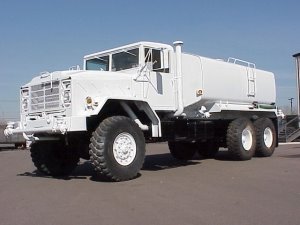It was a moment of understandable celebration because of the vast scope of the work: Trees had been dying at a high rate over the past decade, filling the overgrown forest with what are essentially standing matchsticks ready to explode.
For more than three years, dead and ailing trees have been coming down at a rate of 750 per day, boosted by a $70million grant from the federal government.
But as the sun shined brightly on another uncommonly warm March afternoon, the circumstances of that day's weather caused some concern.
"Normally, firefighters would be packing sandbags right now," said David Stuart, a mountain resident and leader of the nonprofit group Rebuilding Mountain Hearts & Minds, which was born out of the devastating 2003 Old Fire that destroyed nearly 1,000 homes. "Instead, they are filling up their pumper engines."
There's been little reason to make sandbags for residents to place around their homes for protection against heavy rainfall.
People used to talk about the region's fire season.
Traditionally, it lasted from June when temperatures rose and moisture levels plummeted - to late November, when rain tends to fall in the valleys and snow blankets the San Bernardino Mountains.
Those days are becoming a memory.
The reasons are twofold: a warming trend further drying out an arid region thanks to a Mediterranean climate that provides little moisture; and population growth in traditionally rural areas that are difficult to defend from wildfires.
Despite the rain that fell in recent days, Southern California is heading toward a historic low in rainfall.
Normally, this time of year is a favorite for flower enthusiasts. But the lack of any real sustained moisture has left the mountains and deserts devoid of their typical spring blooms - another sign of the region's dryness.
It's also a foreboding indication of this year's wildfire season, because the blooms are critical for retaining moisture and holding off the dry season that normally wouldn't start for a month.
"We've seen this coming for the past several years," said Pat Dennen, chief of the San Bernardino County Fire Department.
Historically, the county Fire Department has requested $500,000 to pay for supplemental, temporary firefighters for the fire season.
"This year, we left them in place because we never really got out of fire season," Dennen said.
Dennen doubted he would ask for additional funds above the $500,000 for the next fiscal year, which begins July 1.
The reason? He credited the county Board of Supervisors for consistently beefing up his full-time roster of firefighting jobs over the years.
Like the county, the California Department of Forestry and Fire Protection has been readying for year-round firefighting.
Following some then-uncharacteristic wildfires in winter months during the mid-1990s, CDF officials began looking at how the fire season was changing.
The department is in the second of a three-year trial program that is keeping some fire stations open year-round, said Bill Peters, a CDF spokesman. Those stations are in and around San Bernardino, Riverside and San Diego.
Normally, stations like those in Chino Hills and Phelan would shut down during the wetter, winter months, Peters explained.
"Now, the bulk of them are left open with an engine crew stationed there," Peters said, estimating that about 60 percent of stations have stayed open.
Yet while the firefighters are there to battle wildfires, their main responsibility during the winter months is prevention inspections, he added.
"Our inspections are going up exponentially," Peters said, explaining that by making homes and properties safer, it reduces a wildfire's destructive abilities. "The Legislature wanted to see how it was working, making sure they got their money's worth.
"I'd say it's working out pretty well."
